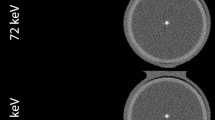Abstract
Coronary computed tomography (CT) angiography is a noninvasive method for visualizing coronary artery disease. However, coronary CT angiography is limited in assessment of stenosis severity by the partial volume effect and calcification. Therefore, an accurate method for assessment of stenosis severity is needed. A 10 cm diameter cylindrical Lucite phantom with holes in the range of 0.4–4.5 mm diameter was fitted in a chest phantom. The holes were filled with an iodine solution of 8 mg/mL. To simulate coronary artery disease, different levels of stenosis were created by inserting Lucite rods into the holes with diameter range of 2–4.5 mm. The resulting lumen cross sectional areas ranged from 1.4 to 12.3 mm2. To simulate arterial calcification, calcium hydroxyapatite rods were inserted into the holes with diameter range of 2–4.5 mm. Images of the phantoms were acquired at 100 kVp using a 320-slice CT scanner. A maual and a semi-automated technique based on integrated Hounsfield units was used to calculate vessel cross-sectional area. There was an excellent correlation between the measured and the known cross-sectional area for both normal and stenotic vessels using the manual and the semi-automated techniques. However, the overall measurement error for the manual method was more than twice as compared with the integrated HU technique. Determination of vessel lumen area using the semi-automated integrated Hounsfield unit technique yields more than a factor of two improvement in precision and accuracy as compared to the existing manual technique for vessels with and without stenosis. This technique can also be used to accurately measure arterial cross-sectional area in the presence of coronary calcification.








Similar content being viewed by others
References
Achenbach S, Daniel WG (2001) Noninvasive coronary angiography—an acceptable alternative? N Engl J Med 345(26):1909–1910
Budoff MJ et al (2008) Diagnostic performance of 64-multidetector row coronary computed tomographic angiography for evaluation of coronary artery stenosis in individuals without known coronary artery disease: results from the prospective multicenter ACCURACY (Assessment by Coronary Computed Tomographic Angiography of Individuals Undergoing Invasive Coronary Angiography) trial. J Am Coll Cardiol 52(21):1724–1732
Min JK, Shaw LJ, Berman DS (2010) The present state of coronary computed tomography angiography a process in evolution. J Am Coll Cardiol 55(10):957–965
Goldstein JA et al (2007) A randomized controlled trial of multi-slice coronary computed tomography for evaluation of acute chest pain. J Am Coll Cardiol 49(8):863–871
Meijboom WB et al (2008) Comprehensive assessment of coronary artery stenoses: computed tomography coronary angiography versus conventional coronary angiography and correlation with fractional flow reserve in patients with stable angina. J Am Coll Cardiol 52(8):636–643
Nissen SE (2008) Limitations of computed tomography coronary angiography. J Am Coll Cardiol 52(25):2145–2147
Marwan M et al (2011) Coronary vessel and luminal area measurement using dual-source computed tomography in comparison with intravascular ultrasound: effect of window settings on measurement accuracy. J Comput Assist Tomogr 35(1):113–118
Komatsu S et al (2014) Quantitative analysis of coronary vessels with optimized intracoronary CT number. Plos One 9(1):e85312
Jiayin Z et al (2015) Quantification of coronary artery stenosis by area stenosis from cardiac CT angiography. Conf Proc IEEE Eng Med Biol Soc 2015:695–698
Kruk M et al (2014) Impact of coronary artery calcium characteristics on accuracy of CT angiography. JACC Cardiovasc Imaging 7(1):49–58
Miller JM et al (2008) Diagnostic performance of coronary angiography by 64-row CT. N Engl J Med 359(22):2324–2336
Fuchs A et al (2015) Feasibility of coronary calcium and stent image subtraction using 320-detector row CT angiography. J Cardiovasc Comput Tomogr 9(5):393–398
Huo Y et al (2012) A validated predictive model of coronary fractional flow reserve. J R Soc Interface 9(71):1325–1338
Molloi S et al (2017) Accurate quantification of vessel cross-sectional area using CT angiography: a simulation study. Int J Cardiovasc Imaging 33(3):411–419
Rasband WS (1997–2005) ImageJ. http://rsb.info.nih.gov/ij/
Leber AW et al (2005) Quantification of obstructive and nonobstructive coronary lesions by 64-slice computed tomography: a comparative study with quantitative coronary angiography and intravascular ultrasound. J Am Coll Cardiol 46(1):147–154
Vavere AL et al (2011) Coronary artery stenoses: accuracy of 64-detector row CT angiography in segments with mild, moderate, or severe calcification—a subanalysis of the CORE-64 trial. Radiology 261(1):100–108
Abdulla J et al (2012) Influence of coronary calcification on the diagnostic accuracy of 64-slice computed tomography coronary angiography: a systematic review and meta-analysis. Int J Cardiovasc Imaging 28(4):943–953
Kim HJ et al (2010) Patient-specific modeling of blood flow and pressure in human coronary arteries. Ann Biomed Eng 38(10):3195–3209
Koo BK et al (2011) Diagnosis of ischemia-causing coronary stenoses by noninvasive fractional flow reserve computed from coronary computed tomographic angiograms. Results from the prospective multicenter DISCOVER-FLOW (Diagnosis of Ischemia-Causing Stenoses Obtained Via Noninvasive Fractional Flow Reserve) study. J Am Coll Cardiol 58(19):1989–1997
Min JK et al (2012) Diagnostic accuracy of fractional flow reserve from anatomic CT angiography. JAMA 308(12):1237–1245
Acknowledgements
The authors would like to thank Ms. Rachel Smith for her help with data analysis. This work was supported in part by a Grant from Canon America Medical System Inc.
Author information
Authors and Affiliations
Corresponding author
Ethics declarations
Conflict of interest
S. Molloi has received grant funding from Canon America Medical System Inc.
Rights and permissions
About this article
Cite this article
Molloi, S., Johnson, T., Lipinski, J. et al. A phantom based evaluation of vessel lumen area quantification for coronary CT angiography. Int J Cardiovasc Imaging 35, 551–557 (2019). https://doi.org/10.1007/s10554-018-1452-8
Received:
Accepted:
Published:
Issue Date:
DOI: https://doi.org/10.1007/s10554-018-1452-8




